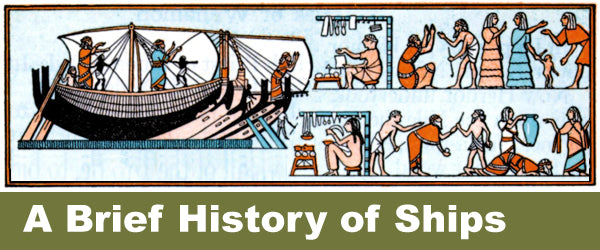
Posted by The Home School in the Woods Team on
All aboard! Today we’re talking about ships.
Most children are intrigued by this mode of transportation, with boats showing up in the bathtub, books, movies, and more! But where in history are boats introduced, and how exactly have they transformed into the luxurious, modern ships of today?
We’re here to give you a brief rundown on the history of boats and ships, and how our hands-on history materials can easily help you cover this mode of transportation in a fun and exciting way!
Who Invented the Boat?
The history of boats goes WAY back – showing up in the Old Testament, Ancient Egypt, and beyond. Unfortunately, no one will ever know when or who built the first boat since there are no written records of its origins.
This being said, some historians think that the oldest recovered boat is the Pesse canoe, found in the Netherlands. This boat was made from a hollowed tree trunk. But it is also believed that boats existed well before this one, with evidence of boats showing up in Genesis during the Great Flood. Searches for Noah’s ark continue to be made, with some claiming to have found it on top of Mount Ararat in Turkey.
Nonetheless, historians agree that boats were being regularly used in history around 4000-3000 BC in Ancient Egypt. The Egyptians used boats to utilize the Nile River. Small boats were used for fishing, and larger sailboats were used to help transport goods like grain, cattle, and building blocks.
Most Egyptian boats were made from papyrus reeds tightly woven together. Their sailboats had a square sail to help the boat move faster and make use of the wind, with oars to help steer. Boats like these would later be used for trading with other civilizations like Mesopotamia.
When Was the First Ship Made?
The Egyptians are responsible for creating the first sailing cargo ships, which were used to transport heavy stones for building monuments. However, the wooden maritime ships that come to mind when we think of sea ships are credited to the Phoenicians, an ancient Canaan civilization that is now known as present-day Syria and Lebanon.
The Phoenicians are responsible for successfully creating wooden sailing vessels called galleys. These types of ships are believed to have been invented around 1150 BC and were low, flat ships powered by one or more sails, with up to three banks of oars. These ships were commonly used for trading, warfare, and piracy.
Not long after this, the Vikings began building narrow longboats. These boats were used for river and sea voyage and sat up to sixty men whose job was to row the ship with oars!
The History of Modern Ships
Ships became more advanced as time went on, with big wooden vessels being used by several different countries for transportation, trading, battle, and more. In fact, if it weren’t for ships, most of the land we live on today wouldn’t have been discovered and settled on!
The design and construction of ships have come a long way since famous, old ships like the Santa Maria traveled from Spain to the New World in 1492. By the 1800s, ships were being lined with iron and propelled by steam, which would later be powered by the burning of coal and then converted to diesel.
Fast-forwarding to the 1900s, ships only continued to get larger and more luxurious (as seen with the “unsinkable” Titanic). Today, ships are being used by the military for our defense, as well as for fishing, leisure, sport, and more. Ships are especially useful in transporting cargo, with about 80% of all goods being transported by ship.
How to Educate Kids About Ships
Some of the greatest stories in history involve different types of ships and boats. Whether it’s learning about Egypt, the New World, or WWI, ships are bound to enter the scene!
If you’re interested in teaching your children about the history of ships so they can better understand them when they show up in history, we recommend first showing your kids what the different parts of a ship are.
By doing this, your kids will better appreciate the intricate details that went into designing and building historical sailing ships. We specifically cover the anatomy of a ship (including hands-on projects) in our New World Explorers study.
We also cover boats and ships in various places throughout our curriculum. As we mentioned, the Egyptians are credited for using some of the first boats and sailing ships. You can find more about Egyptian vessels in our Ancient Egypt Project Passport.
Our Time Travelers talk about ships as well, including the rise of English sea power, which can be found in the Renaissance and Reformation, and ironclad warships from the Civil War.
Finally, our timeline figures cover countless boats throughout history, including clipper ships, the Titanic, and the sinking of the Lusitania. You can learn more about using timelines to teach history in our blog post, Teaching with Timelines.
Sail the Ocean Blue With Your Littles
Fasten your sails and explore the vast history of ships with your kiddos! Their fascination with ships will soon be matched with fun facts (and, of course, pirate lingo and dress-up).
If you’ve got kids who love different modes of transportation (cars, trains, planes, you name it!), then be sure to check out our blog and read more of our Transportation Through the Ages articles.
